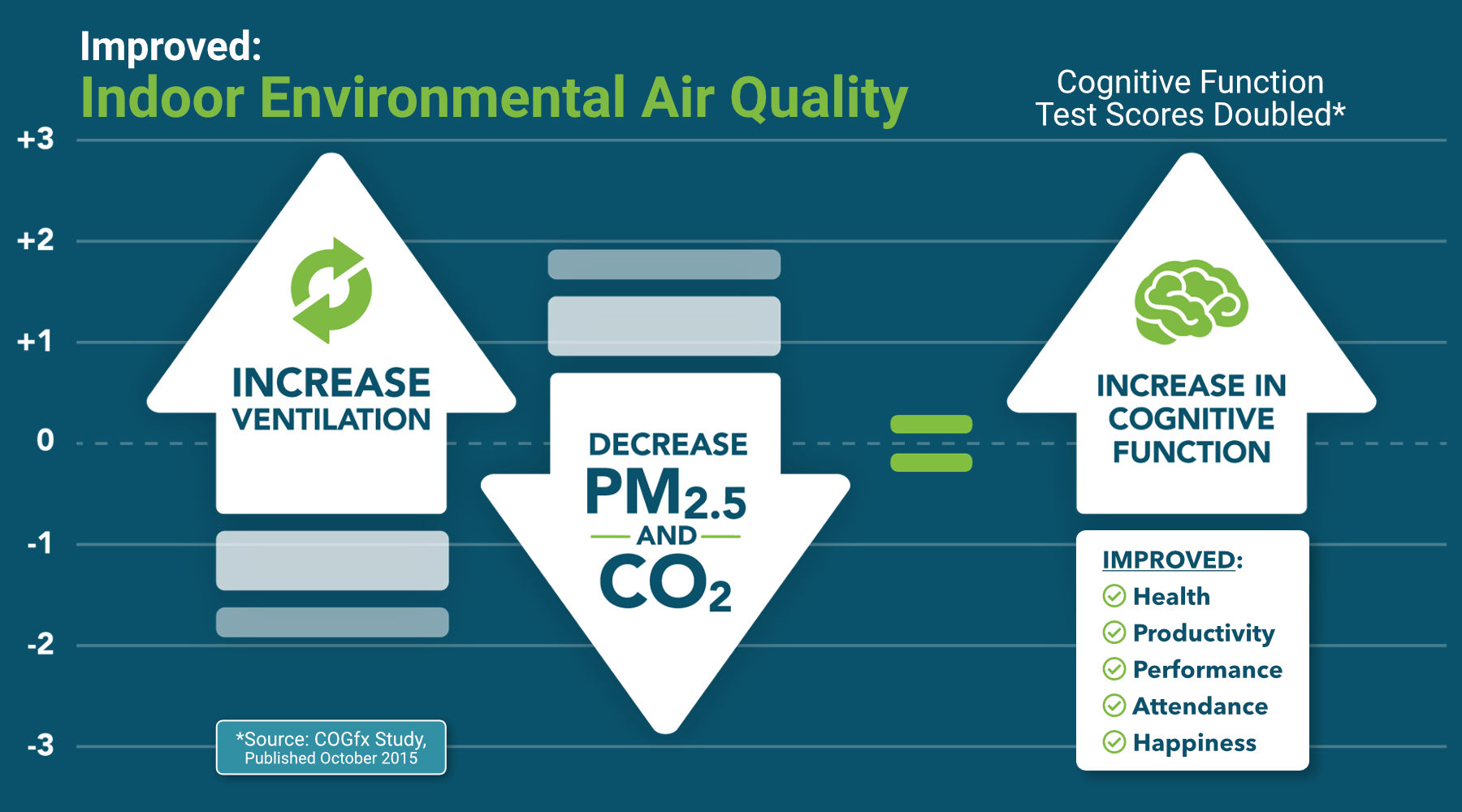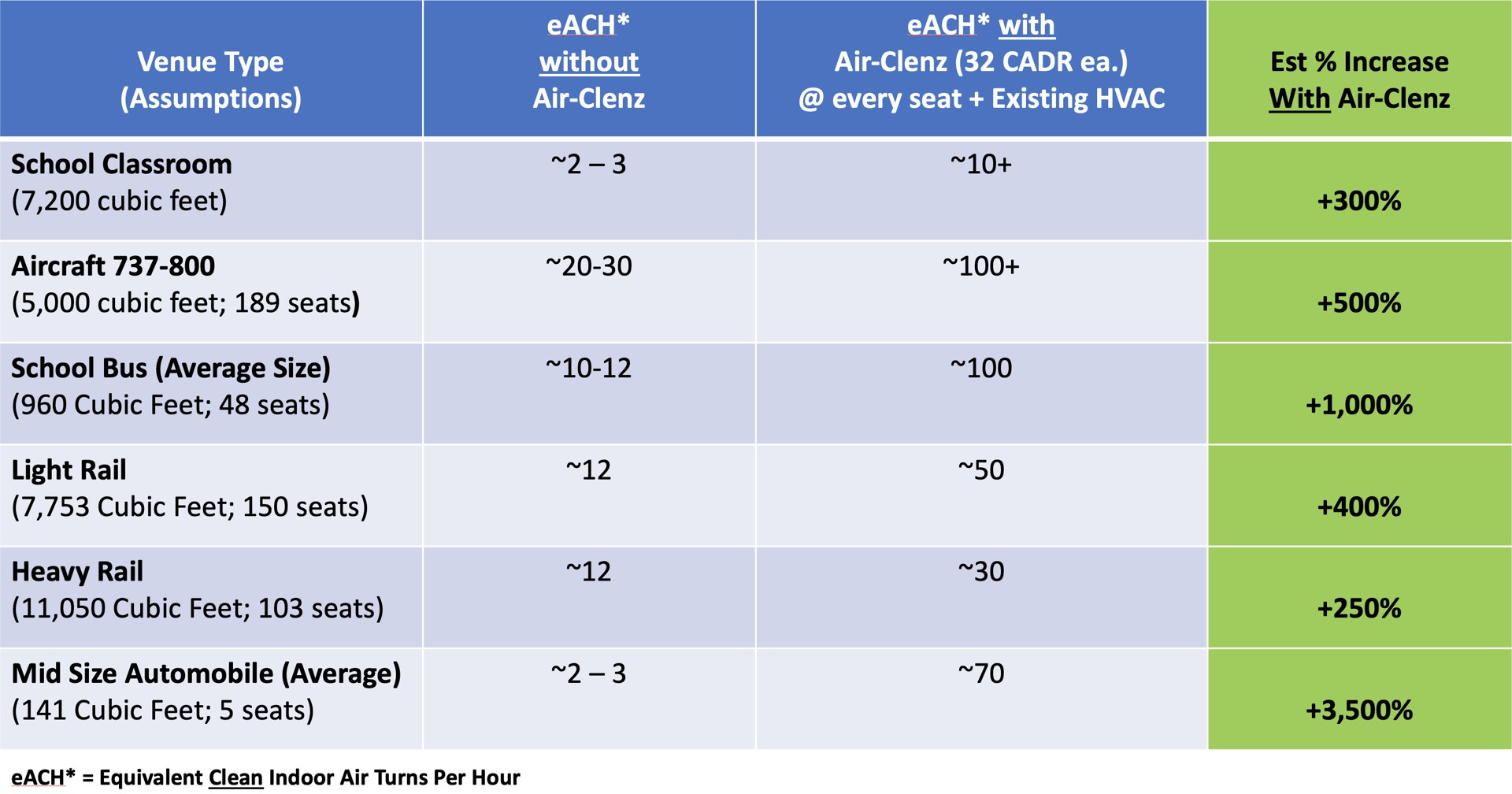
Improving the quality of indoor air can improve the health, cognitive ability, productivity, performance, and happiness of employees and students.
Appropriate indoor air quality also reduces the spread of infectious airborne diseases such as COVID, influenza, RSV, tuberculosis, and the common cold.
Citations / References
i. Joseph G. Allen, et al., Associations between acute exposures to PM2.5 and carbon dioxide indoors and cognitive function in office workers: a multicounty longitudinal prospective observational study, Environ. Res. Lett. 16 (2021) 09404
ii. Steffen Künn et al., Indoor Air Quality and Strategic Decision Making, Management Science, Articles in Advance, pp. 1–24, 2023, ISSN 0025-1909 (print), ISSN 1526-5501 (online)
iii. Joseph G. Allen, et al., Associations of Cognitive Function Scores with Carbon Dioxide, Ventilation, and Volatile Organic Compound Exposures in Office Workers: A Controlled Exposure Study of Green and Conventional Office Environments, Environmental Health Perspectives, volume 124, number 6, pg 805, 2016
i.,iii, iv. https://thecogfxstudy.com
v. The Lancet COVID-19 Commission – Task Force on Safe Work, Safe School, and Safe Travel: Designing infectious disease resilience into school buildings through improvements to ventilation and air cleaning, April 2021
vi. The Lancet COVID-19 Commission – Task Force on Safe Work, Safe School, and Safe Travel: Proposed Non-infectious Air Delivery Rates (NADR) for Reducing Exposure to Airborne Respiratory Infectious Diseases, November 2022
vii. Pawel Wargocki, et al., The relationships between classroom air quality and children’s performance in school, Building and Environment, Volume 173, 2020, 106749
viii. Sasan Sadrizadeh, et al., Indoor air quality and health in schools: A critical review for developing the roadmap for the future school environment, Journal of Building Engineering 57 (2022) 104908
ix. Tess M. Stafford, Indoor air quality and academic performance, Journal of Environmental Economics and Management, 70 (2015), 34–50
x. Haverinen-Shaughnessy U., et al., Effects of Classroom Ventilation Rate and Temperature on Students’ Test Scores. PLoS ONE 10(8): e0136165 (2015)
Clean Indoor Air Turns Per Hour
Increased by Air-Clenz™

Clean Indoor Air Turns Per Hour

Air-Clenz can greatly increase indoor clean air turns per hour for most indoor venues or spaces where it is placed. By way of example only, the average classroom in the United States is said to have approximately 2 – 3 indoor clean air turns per hour. Harvard’s research states that Harvard encourages this number to be 6 clean air turns per hour. With Air-Clenz installed at each students desk the indoor clean air turns per hour for an average classroom in the US will go up to nine (9) and in many cases ten plus (10+) clean air turns per hour.

Air-Clenz Systems™ (Air-Clenz™) invented a totally new approach to improve indoor air quality (IAQ).
Our light bulb moment came when we theorized that to capture and clean exhaled air from 1 inch to 3 feet of one’s face would not only deliver better IAQ, it would also dramatically decrease the spread of infectious airborne pathogens across rooms, aircraft cabins, cars, trains, etc.
We then discovered that, while an HVAC system is both necessary and highly beneficial, it has a fundamental design flaw when it comes to airborne disease: cross-flow and mixing. HVAC systems pull air across a room, from supply vents to returns. This cross-flow means potentially infection-laden exhaled breath is mixed with general room air and pulled past others in the same space. No matter how cutting-edge the cleaning technology used by the HVAC system, its in the wrong place to help prevent the spread of airborne disease. Air-Clenz™ technology is highly complementary to HVAC systems. The combination of multiple Air-Clenz™ units operating with an HVAC system in a room not only reduces cross airborne contamination but also significantly increases clean air turns per hour in the room.
How it Works

Air-Clenz™ utilizes an exhaled air blocking surface which stops the forward movement of exhaled air (breath, cough, sneeze) and allows it to be quickly captured by an air suction intake and then cleaned by a HEPA filter or other mode of air purification.
The Air-Clenz blocking surface can be any surface located within 3 feet in front of the face of a person exhaling air: a monitor screen, backside of a seat back, or an attachment to the front of a desk, etc. Once captured and cleaned, the air is returned to the room 99.97% free of pathogens such as COVID, influenza, RSV, tuberculosis, or the common cold.
